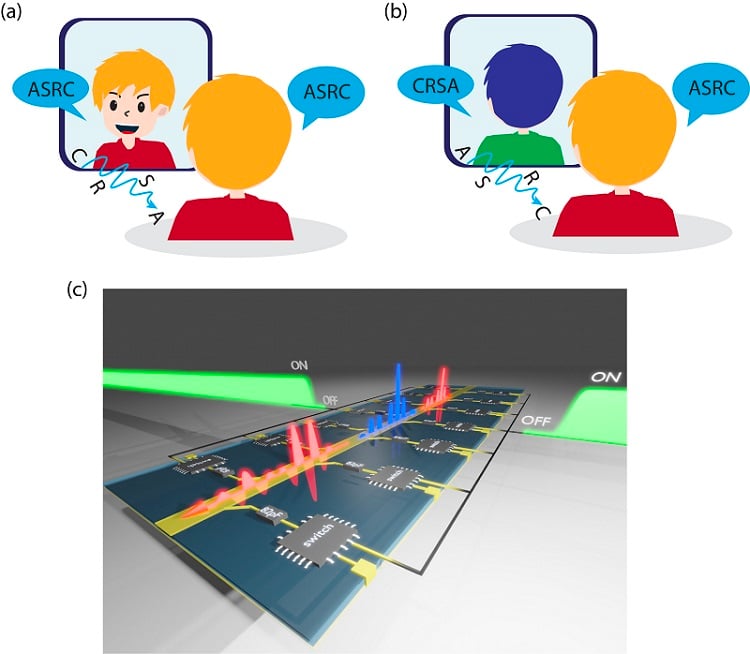The reflected images produced when we look at a mirror are caused by electromagnetic lightwaves bouncing off the mirrored surface and creating the common phenomenon called spatial reflection. Similarly, spatial reflections of sound waves form echoes that carry our words back to us in the same order we spoke them.
For over six decades, scientists have hypothesized about the possibility of a different type of wave reflection, known as a temporal or time reflection. In contrast to spatial reflections, which arise when lightwaves or sound waves hit a boundary such as a mirror or a wall at a specific location in space, time reflections arise when the entire medium through which the wave is traveling suddenly changes its properties across all of space. In this situation, a portion of the wave is time reversed, and its frequency is changed.
To date, this phenomenon had never been observed for electromagnetic waves. The lack of evidence owes to the inability of a material’s optical properties to be easily changed at a speed and magnitude that induces time reflections.
Now, an experiment performed by a team led by Andrea Alù, distinguished professor of physics at the CUNY Graduate Center and founding director of the CUNY Advanced Science Research Center (ASRC) Photonics Initiative, has demonstrated time reflections of electromagnetic signals in a tailored metamaterial.
“This has been really exciting to see, because of how long ago this counterintuitive phenomenon was predicted, and how different time-reflected waves behave compared to space-reflected ones,” Alù said. “Using a sophisticated metamaterial design, we were able to realize the conditions to change the material’s properties in time both abruptly and with a large contrast.”

(a) Conventional spatial reflections: A person sees their face when they look into a mirror, or when they speak the echo comes back in the same order. (b) Time reflections: The person sees their back when they look into a mirror, and they see themselves in different colors. They hear their echoes in a reversed order, similar to a rewound tape. (c) Illustration of the experimental platform used to realize time reflections. A control signal (in green) is used to uniformly activate a set of switches distributed along a metal stripline. Upon closing/opening the switches, the electromagnetic impedance of this tailored metamaterial is abruptly decreased/increased, causing a broadband forward-propagating signal (in blue) to be partially time-reflected (in red) with all its frequencies converted. (Adapted from Nature Physics.) Courtesy of Andrea Alù/City University of New York.
The feat caused a significant portion of the broadband signals traveling in the metamaterial used by the researchers to be instantaneously time reversed and frequency converted. The effect differs from a traditional echo, in that the last part of the signal is reflected first.
Applying this concept to a mirror, the subject would see their reflection flipped and would be looking at their back instead of their face. Acoustically, an echoed phrase would be heard similarly to what is produced when a tape is rewound.
The researchers also demonstrated that the duration of the time-reflected signals was stretched in time due to broadband frequency conversion. As a result, if the light signals were visible, their colors would be abruptly transformed, such that red would become green, orange would turn blue, and yellow would appear violet.
Using engineered metamaterials for the experiment, the researchers injected broadband signals into a meandered strip of metal, about 6 m long, printed on a board and loaded with a dense array of electronic switches connected to reservoir capacitors. All of the switches were triggered at the same time, suddenly and uniformly doubling the impedance along the line. This quick and large change in electromagnetic properties produced a temporal interface, and the measured signals faithfully carried a time-reversed copy of the incoming signals.
The experiment demonstrated that it is possible to realize a time interface, producing efficient time reversal and frequency transformation of broadband electromagnetic waves. Both of these operations offer new degrees of freedom for extreme wave control. The achievement can pave the way for exciting applications in wireless communications and for the development of small, low-energy, wave-based computers.
“The key roadblock that prevented time reflections in previous studies was the belief that it would require large amounts of energy to create a temporal interface,” said Gengyu Xu, a postdoctoral researcher at CUNY ASRC. “It is very difficult to change the properties of a medium quick enough, uniformly, and with enough contrast to time reflect electromagnetic signals because they oscillate very fast.”
The researchers instead created a metamaterial in which additional elements could be abruptly added or subtracted through fast switching, bypassing the need to change the properties of the host material.
"The exotic electromagnetic properties of metamaterials have so far been engineered by combining in smart ways many spatial interfaces,” said Shixiong Yin, a graduate student at CUNY ASRC and at The City College of New York. “Our experiment shows that it is possible to add time interfaces into the mix, extending the degrees of freedom to manipulate waves.
According to Yin, the researchers also created a time version of a resonant cavity. This cavity can be used to realize a new form of filtering technology for electromagnetic signals, he said.
Combined with tailored spatial interfaces, the discovery offers the potential to open new directions for photonic technologies, as well as new ways to enhance and manipulate wave-matter interactions.
This research was partially supported by the Air Force Office of Scientific Research and the Simons Foundation.
The research was published in Nature Physics (www.doi.org/10.1038/s41567-023-01975-y).